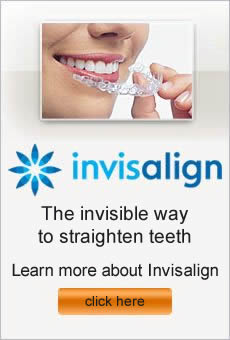Do you cringe at the thought of metal braces, but still want to obtain a fantastic smile? You shouldn’t have to sacrifice your mature image to straighten your teeth. With Invisalign clear braces, you don’t have to endure the discomfort or embarrassment of traditional orthodontia.
Adult and older teen patients often love the option of Invisalign clear braces. Through a series of clear, custom aligners, this advanced system gently shifts crooked teeth into the desired position. With these virtually undetectable aligners, only you and your orthodontist will realize that you are undergoing treatment to improve your smile.
Before beginning treatment, your orthodontist will first complete a full analysis to make sure Invisalign is the right solution for your case. Your doctor will then take photos and collect data to create an exact treatment plan. Using advanced 3-D technology, the Invisalign lab will translate the orthodontist’s instructions into a complete series of aligners.
During treatment, you will wear each aligner for around two weeks; then, switch to the next aligner. You will visit the orthodontist every four to six weeks so that the doctor can monitor your progress. Remove the aligners when you eat, brush, and floss, or for special occasions. In about 12 months, you can reveal a flawless smile to family and friends.
Benefits of Invisalign:
• Makes cleaning and home care easier
• No bulky metal brackets
• No painful adjustments
• Usually requires less treatment than traditional therapy
Invisalign at Sherman Oaks Orthodontist Mehdi Fotovat Valley Village, CA
Though babies and toddlers use thumb-sucking to self-sooth, this habit can cause dental problems if your child continues as he or she grows up. By age six, you should work on curbing this habit so that you don’t end up with correct teeth, bite concerns, or additional treatment costs. Talk with your dentist or orthodontist for specific recommendations about handling the issue.
The following suggestions may help you work with your child to stop the thumb-sucking:
• Use positive affirmations. Instead of scolding your child for thumb-sucking, offer praise when he or she isn’t engaged in the behavior.
• Dig deeper. Often, children suck their thumbs because of fear or anxiety.
• Identifying the cause of the concerns may reduce your child’s need for this type of comfort.
• Create a plan. Talk with your child and get his or her input for the best way to stop the thumb-sucking. When you involve your child in the process, you may see more willing participation.
• Call in reinforcements. Ask your dentist and/or orthodontist to speak with your child and explain the oral health consequences for thumb-sucking.
• Add a deterrent. Sometimes, placing a sock over the thumb, wrapping a bandage around the digit, or using a thumb guard will make it difficult for your child to keep up the habit.
• Offer incentives. Let your child come up with a special reward for kicking the thumb-sucking habit. A new video game, coveted toy, or special dinner may provide the necessary push your child needs.
Straight teeth at Mehdi Fotovat Sherman Oaks Orthodontist
While having to wear braces or other orthodontia may not be a lot of fun, most people enjoy straighter, gorgeous smiles because of this treatment time. The short-term hassles will produce lasting results. To get the maximum benefit from your orthodontic treatment, you need to follow these simple steps:
Be careful
Having braces shouldn’t impact your life in most cases, but you do need to make some adjustments. Stay away from hard foods and candies because they can damage brackets and wires. If you play sports, talk with your orthodontist about the type of mouth guard you need to wear with braces.
Follow instructions
Make sure to wear rubber bands, head gear, or other additional appliances as directed. Not wearing these devices can lengthen treatment time.
Don’t neglect your teeth
Though brushing and flossing are always important, they are particularly critical if you have braces. Food can easily get trapped between brackets and wires, creating a fertile breeding ground for bacteria and making your mouth susceptible to issues like tooth decay and gum disease.
Keep your appointments
Your orthodontist plans the visits at regular intervals to monitor the movement of your teeth and make necessary adjustments. Missing your scheduled appointment at the orthodontist can slow down your progress.
Continue regular dental visits
Because braces make routine oral care more difficult, you need to keep your appointments for semi-annual checkups. Your dentist and hygienist will examine your mouth and clean your teeth to promote good oral health.
Mehdi Fotovat Sherman Oaks Orthodontist
Although most people want a straight smile because it looks good, you receive other benefits of orthodontic treatment. Crowded and crooked teeth are harder to maintain, which can result in increased problems with tooth decay or gum disease. As well, a bad bite, or malocclusion, can make chewing difficult and cause uneven tooth wear.
Common orthodontic issues include:
Crossbite
This type of problem occurs when the upper teeth rest significantly inside or outside the lower teeth. Crossbites make chewing tough and can cause issues with proper jaw growth.
Crowding
A small mouth, larger teeth, or a narrow jaw can make it difficult for permanent teeth to move into the correct spot.
Deep overbite
If the incisors, the upper front teeth, overlap too far over the lower teeth, a deep overbite results.
Under bite
The lower teeth can be positioned ahead of the upper teeth and create an under bite, which may suggest that the jaws are not in the right position.
Open bite
When your upper and lower teeth don’t meet as you bite down, this condition is called an open bite. Having an open bite can make biting difficult, impact speech, and produce uneven wear on teeth.
Spacing problems
If an individual has particularly small teeth or has lost teeth, this situation can produce larger spaces between teeth.
Because each person’s bite is different, the orthodontic treatment course will vary slightly from individual to individual. Braces are a common choice to correct bite issues. Your orthodontist will evaluate your mouth and then create a detailed plan for improving your smile and oral health.
We create beautiful smiles at Mehdi Fotovat Sherman Oaks Orthodontist
When you have braces, oral care can be tricky. Brackets, wires, rubber bands, and other orthodontic appliances can catch food. Breakage can occur if you don’t watch what you eat. Understanding how to protect your orthodontia and your teeth will help ensure a successful outcome.
Flossing with Braces
Although flossing is more difficult, it’s especially important when you have braces. To make it easier you may need to buy flossers, which will help you thread the floss between the wires. As you floss, don’t pull to hard on the arch wire.
Brushing Tips
With braces, you need to brush after every meal to remove any trapped food particles. Carry a travel toothbrush and toothpaste to make it easier during your busy day.
Avoid Problem Foods
Certain choices like sticky treats and hard substances aren’t a good idea while you have braces. Pretzels, popcorn, suckers, and taffy can pull off brackets or damage wires, so save these goodies for after you finish treatment.
Safeguard Your Smile
If you play sports or participate in activities that could involve contact, like basketball, soccer, and even skateboarding, ask your orthodontist about a mouth guard. These plastic devices cover teeth and gums to prevent mouth injuries.
Keep your orthodontist informed
If you break a bracket or have a wire come loose, call your orthodontist’s office and find out the next steps. You can cover the area with dental wax to prevent irritation. Don’t try to repair the problem yourself because you could cause further damage.
Sherman Oaks, CA orthodontic office – Mehdi Fotovat, DDS.



